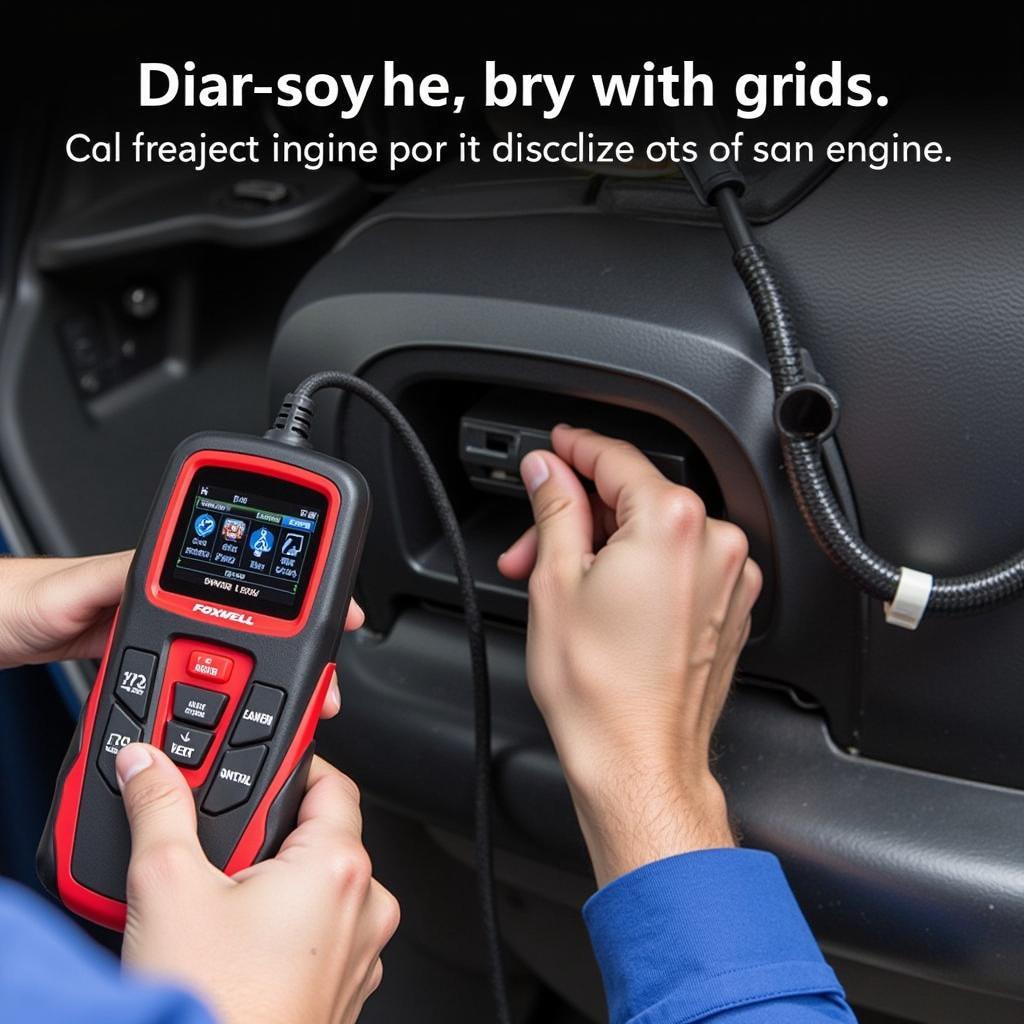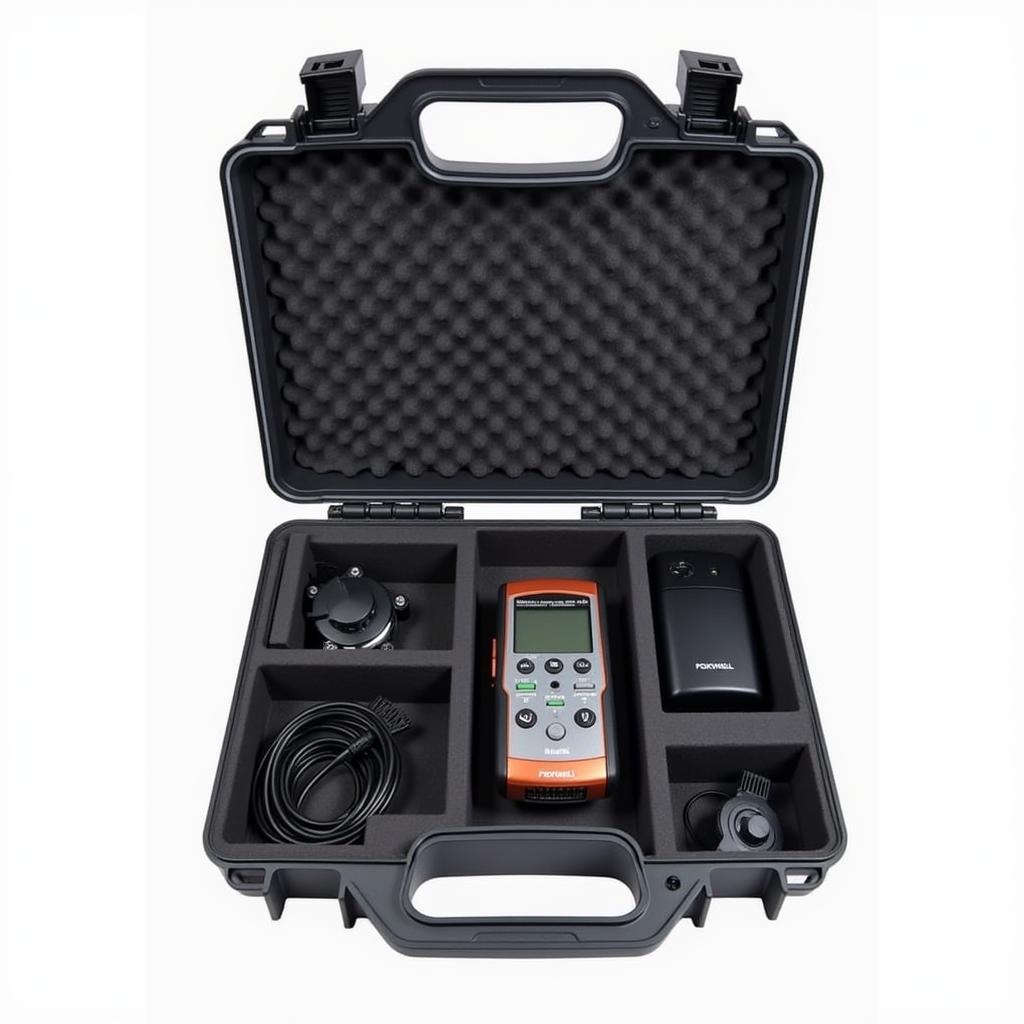Foxwell Scanners With Live Data have become essential tools for car owners and mechanics alike. These powerful devices offer a window into your vehicle’s inner workings, allowing you to diagnose issues with greater speed and accuracy. Whether you’re a DIY enthusiast or a seasoned professional, understanding how to leverage live data can significantly enhance your diagnostic capabilities.
[image-1|foxwell-scanner-live-data|Foxwell Scanner Displaying Live Data|A Foxwell scanner connected to a car’s OBD-II port, displaying live sensor data on its screen. The screen shows various parameters like engine RPM, coolant temperature, and oxygen sensor readings, providing real-time insights into the vehicle’s performance.]
Why Live Data Matters in Automotive Diagnostics
Traditional OBD-II scanners primarily focus on retrieving diagnostic trouble codes (DTCs), which are essentially error codes stored in your car’s computer. While DTCs provide a starting point for troubleshooting, they often lack the context to pinpoint the root cause of a problem.
This is where live data comes into play. Live data provides real-time feedback from various sensors throughout your vehicle, including:
- Engine RPM: This indicates how fast your engine is rotating.
- Coolant Temperature: Monitors the engine’s operating temperature.
- Oxygen Sensor Readings: Measures the oxygen content in the exhaust gases, crucial for fuel efficiency.
- Throttle Position: Shows how far the accelerator pedal is depressed.
- Vehicle Speed: Provides accurate speed readings independent of the speedometer.
By analyzing these and other live data parameters, you can gain a comprehensive understanding of your vehicle’s performance under various operating conditions. This allows you to:
- Verify sensor readings: Ensure sensors are providing accurate data.
- Identify intermittent problems: Detect issues that might not trigger a DTC.
- Confirm repairs: Verify that a repair has successfully addressed the underlying problem.
For instance, if you’re experiencing rough idling, a foxwell nt614 obdii can display live data from the Mass Air Flow (MAF) sensor, oxygen sensors, and throttle position sensor. This allows you to quickly pinpoint whether a faulty sensor or a mechanical issue is causing the problem.
[image-2|mechanic-using-foxwell-scanner|Mechanic Using Foxwell Scanner for Diagnostics|A mechanic in a professional garage uses a Foxwell scanner to diagnose a car. He is looking at the scanner’s screen, which displays live data streams and diagnostic information. Tools and equipment are visible in the background, signifying a professional automotive repair environment.]
Choosing the Right Foxwell Scanner for Your Needs
Foxwell offers a range of scanners with varying levels of functionality and live data capabilities. When choosing a scanner, consider factors such as:
- Vehicle Coverage: Ensure the scanner supports your vehicle’s make, model, and year.
- Live Data Functionality: Look for scanners that offer comprehensive live data parameters relevant to your diagnostic needs.
- Additional Features: Consider features like bi-directional controls (for activating components), advanced coding capabilities, and special functions for specific vehicle systems (ABS, airbag, etc.).
For DIY users or those needing basic diagnostics, the Foxwell NT614 offers a solid set of features at an affordable price. If you require more advanced capabilities, the foxwell nt 630 plus dealer provides comprehensive live data, bi-directional controls, and extensive vehicle coverage.
Making the Most of Live Data: Tips and Tricks
To effectively utilize live data, keep the following tips in mind:
- Understand the Data: Familiarize yourself with the meaning and normal ranges of the live data parameters you’re monitoring. Refer to your vehicle’s service manual or reliable online resources for this information.
- Establish a Baseline: With the engine running smoothly, record the values of key live data parameters. This establishes a baseline for comparison when troubleshooting.
- Look for Deviations: Pay close attention to any significant deviations from the baseline or expected values. These deviations often provide clues about potential issues.
- Utilize Graphing Functions: Many Foxwell scanners offer graphing capabilities, allowing you to visualize live data trends over time. This can be particularly helpful for identifying intermittent problems.
“When diagnosing complex engine issues, I always rely on the graphing function of my Foxwell scanner. It allows me to easily spot patterns and anomalies that might not be apparent just by looking at raw data,” says John Smith, a certified master mechanic with over 20 years of experience.
[image-3|foxwell-scanner-graphing-data|Foxwell Scanner Displaying Graphing Data|The screen of a Foxwell scanner showing live data displayed in a graphical format. The graph illustrates changes in sensor readings over a period, allowing for easier identification of trends and patterns.]
Beyond Diagnostics: Live Data for Performance Monitoring
While primarily used for diagnostics, Foxwell scanners with live data can also be valuable tools for performance monitoring. By tracking live data parameters during test drives or performance runs, you can:
- Monitor engine performance: Analyze parameters like RPM, intake air temperature, and ignition timing to assess engine health and efficiency.
- Evaluate modifications: Assess the impact of performance upgrades on parameters such as boost pressure (for turbocharged engines) or air/fuel ratio.
- Track vehicle health: Regularly monitoring live data can help you identify potential issues before they escalate into major problems.
Whether you’re a car enthusiast, a DIY mechanic, or a professional technician, Foxwell scanners with live data offer a powerful means to diagnose, repair, and even enhance your vehicle. By understanding how to effectively utilize these versatile tools, you can gain a deeper understanding of your car’s inner workings and keep it running smoothly for years to come.
FAQs About Foxwell Scanners with Live Data
Q: Can I use a Foxwell scanner with live data on any car?
A: Foxwell scanners offer varying vehicle coverage. It’s crucial to choose a model compatible with your car’s make, model, and year.
Q: Do I need any special skills to interpret live data?
A: While basic automotive knowledge is helpful, numerous online resources and forums can assist with interpreting live data.
Q: Are Foxwell scanners with live data only for professionals?
A: Not at all! Foxwell offers scanners for various skill levels, from DIY enthusiasts to professional mechanics.
Q: Can live data help me save money on car repairs?
A: Absolutely! By identifying issues early on, you can often address them before they require costly repairs.
Q: Can I use a Foxwell scanner to clear DTCs?
A: Yes, most Foxwell scanners allow you to clear DTCs once you’ve addressed the underlying problem.
Need expert advice on choosing the right Foxwell scanner for your needs? Contact ScanToolUS at +1 (641) 206-8880 or visit our office at 1615 S Laramie Ave, Cicero, IL 60804, USA. We’re here to help you find the perfect diagnostic tool for your automotive needs!



Pingback: Foxwell Inc: Your One-Stop Solution for Automotive Diagnostics and Repair - Car Scan Tool
Pingback: Snag a Deal on the Foxwell NT-630: Is This OBD2 Scanner Worth It? - Car Scan Tool
Pingback: Foxwell NT614 Pro: The Mechanic's Best Friend for Efficient Car Diagnostics - Car Scan Tool
Pingback: Unlock Your Car's Secrets: A Comprehensive Guide to Foxwell Diagnostic Scanners - Car Scan Tool